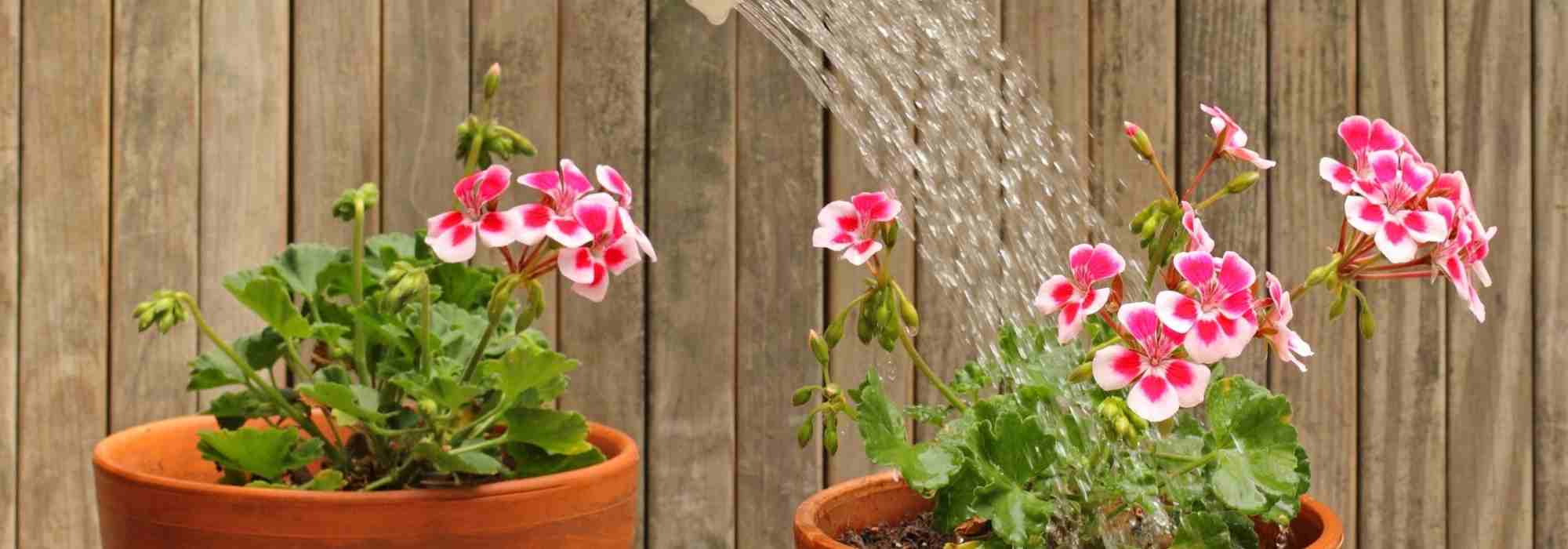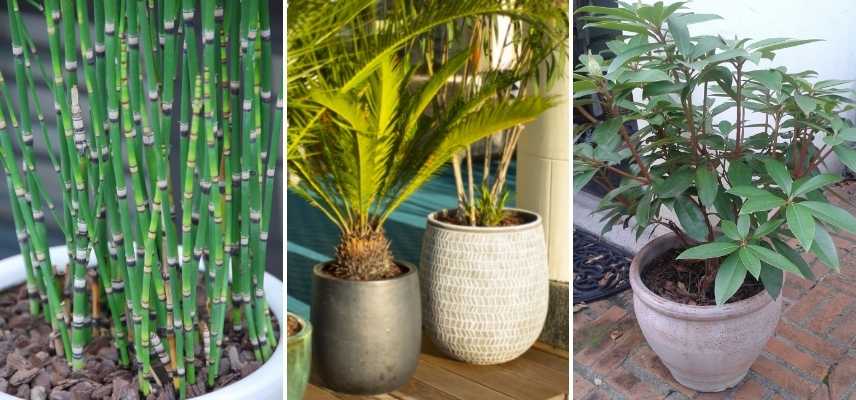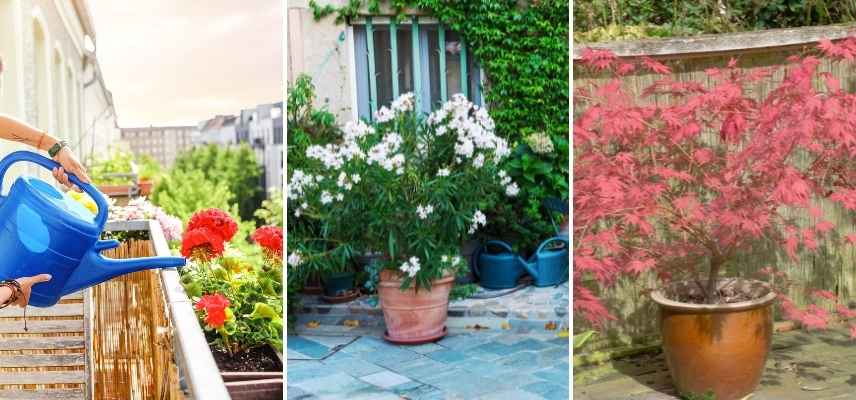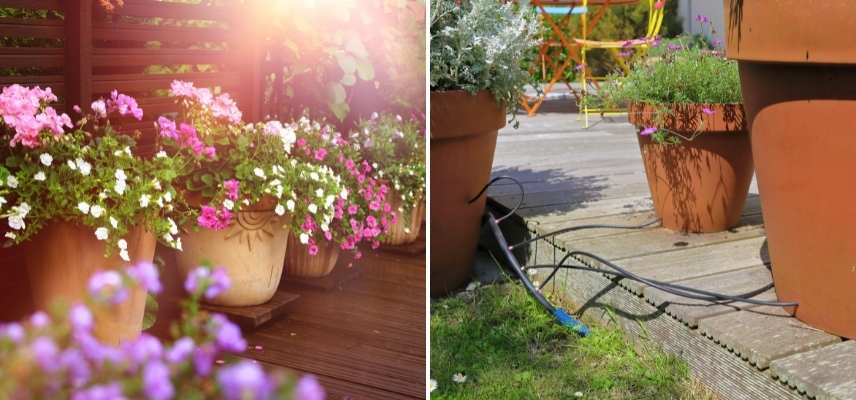
Watering potted plants
How to water your plants grown in containers, window boxes, or pots effectively?
Contents
Water… is life! For our plants, which are often made up of more than 85% water, it is essential for the vital development of their tissues, ensuring the transport of mineral elements. When planted in a pot on a balcony or terrace, watering is essential for the plant as it cannot absorb water from deeper soil with its roots, nor can it rely solely on occasional rain. Therefore, it needs a bit more assistance, while being careful not to become a slave to your potted plants. Additionally, there are tips to make this task easier: choosing the right substrate, pot, implementing mulching, and using sensible techniques or innovations in watering.
We will tell you everything you have always wanted to know about watering your potted plants, to master it well and… water them better!

Potted plants require more watering than the same plants growing in the ground
Respecting the water requirements of plants
It goes without saying that you won’t water a plant in cool or moist soil, such as a arum planted in a large pot with a significant foliar surface, in the same way as a succulent plant with small leaves growing in rocky terrain in its natural habitat, like a houseleek. From this observation, it is essential to consider the needs of each plant. Whether planted in the ground or in a pot, a plant requires varying watering needs depending on its nature (sometimes almost none), which is generally indicated at the time of purchase on its reminder label by symbols often representing water droplets. The same applies in books or magazines, and on your favourite online plant site! Along with exposure and soil type, watering is indeed the third essential criterion for the development of your plants.
Some bushes, like boxwood planted in pots, do not appreciate diffuse watering like drip irrigation. So, be sure to check the characteristics of each plant for this specific planting.
If you are often away or if watering is not a relaxing end-of-day moment for you, you will need to pay close attention to the choice of plants you install in pots; there are many that tolerate drought well, even in pots, such as Tulbaghias, Buenos Aires verbenas, Sedums, or fescues.
→ Discover 10 drought-resistant perennials and bushes that withstand drought well

You won’t water a plant in cool soil like horsetail, a palm or Cycas in a pot, and a rhododendron in the same way…
Choosing the right substrate
Pay particular attention to the substrate that will nourish the plant. This point is essential in our watering discussion, as the soil feeds the plant, and in pots, the volume is limited! Forget about low-quality potting mixes for this container culture; opt for potting mixes for containers and pots with high water retention capabilities. Your substrate should also be able to rehydrate well after any drying out. You will mix quality garden soil with potting mix, and for plants that prefer dry conditions, lighten the mix with a portion of sand or small gravel to enhance drainage capacity. This helps such plants, especially in winter, to suffer less from humidity.
A portion of the substrate should be renewed each year at the end of winter by surface topping (renewing about a quarter of the substrate from the surface). For aging plants, it is necessary to completely replace the substrate to restore their vitality.

The choice of substrate is crucial
The importance of the pot
Your pots or containers play a crucial role in watering, depending on their size, material, and whether or not they have a drainage hole.
- Size: Of course, the larger the pot, the more significant the water reserve for the plant, as the soil dries out less quickly. It is especially important to match the pot size to the plant. Many varieties of bushes, for example, can be planted in pots – you should select compact cultivars with reduced growth – provided you give them a sufficiently large container (especially in depth) to develop their roots.
- Material: This is also important as some materials retain freshness more or less effectively. Due to its porosity, terracotta retains little water and is well-suited for dry soil plants. In contrast, plastic, stone, or concrete tend to retain water well, with minimal evaporation: ideal for plants that prefer moist conditions. Be cautious with dark colours that absorb heat…
- Drainage hole: A pot with a drainage hole is usually recommended: it allows excess water to escape during watering, and when a saucer is placed under the pot, it helps retain some moisture that will later seep back in. However, for water-hungry plants (often characterised by large, glossy foliage: Arums, Farfugiums…) and aquatic plants, it is best to choose a pot without a drainage hole to help the plant retain maximum moisture, which is beneficial for its health.
- Water-retaining containers: A double base allows for a small water reserve for the plant, with a gauge indicating when this reservoir is empty. Often less aesthetically pleasing and used indoors, they are useful for those who tend to forget to water their plants… but one must remember to refill them!
 The material, as well as the colour and dimensions of a pot, will influence the moisture retention of the substrate.
The material, as well as the colour and dimensions of a pot, will influence the moisture retention of the substrate.
Read also
Watering the garden: how to do it?When and how to (properly) water?
Watering and managing the watering of your plants when grown in pots is not always easy. In these more challenging living conditions for plants, there is often a tendency to overwater or, conversely, to forget them… Even though plants do not all have the same needs, there are some basic rules to follow:
- Water slowly, allowing the substrate time to absorb the water properly. If you water too quickly on dry soil, for example after returning from holiday, you will find that the water quickly drains out through the pot’s drainage hole. The result: your watering will be ineffective as part of it is lost.
- Always allow the substrate to dry out between waterings. It is better to water thoroughly two or three times a week than a little bit every day.
- To determine if your plants need water, insert your finger into the substrate: dry on the surface but still moist at 3 cm deep means the plant is still self-sufficient. If the substrate is dry deeper down, it needs watering.
- In case of a heatwave or prolonged drought, be very vigilant, especially if the exposure is south-facing: your potted plants are much more vulnerable than those planted in the ground. Some may require daily watering or even twice a day. Observe the foliage: is it wilted, soft, or dry? It’s high time to water. For more woody plants or those with tough foliage, you can assess the need for watering by “sensing” the soil a few centimetres down.
- Like in the garden, get into the habit of watering early in the morning or in the evening, to minimise evaporation.
- Avoid watering the foliage, as this can lead to diseases. Position your watering can so that only the soil is watered: around the collar for a bush, or at the centre of the clump for perennials.
- From spring to the end of summer, potted plants need the most watering to support their growth and flowering. In winter, stop watering your plants that remain on a balcony or terrace. Seasonal rains will suffice. For succulent plants or agaves, excess moisture is to be feared. Place them in a spot protected from rain, and for some, bring them into a cold greenhouse or frost-free area.
- The watering water should not be too cold… nor too hot, so at room temperature, and if possible, rainwater will always be more beneficial.
- Pay extra attention to your balcony planters that do not benefit from rain as they are (too) well sheltered by the building: these planters or pots require much more watering than others.
- Under a cold greenhouse, some tender evergreen plants will need controlled watering in winter, every two weeks at most. Citrus trees often need to keep the soil slightly moist, so it’s important to space out the waterings accordingly.

Special care should be taken with planters in full sun. Water large potted plants a little less often, wait for the substrate to dry, and ideally water at the end of the day.
Managing long periods of absence
Different techniques help us manage absences that could be fatal to potted plants if not implemented!
- First, gather and move your pots and containers as much as possible into the shade.
- Drip irrigation: equipping your balcony or terrace with a drip irrigation system is the number one method for efficiency during a long absence. The drippers placed in each pot will water them at a frequency and quantity you have programmed. This system, of course, requires access to a tap.
- The inverted bottle system: ancient, although not very aesthetic (but who cares, since we won’t be there…), it allows for managing a short absence by diffusing water into the pots. Even better, with clay cone-type tips, the water diffuses more slowly.
- Mini ollas: just like their larger counterparts installed in the garden or vegetable patch, mini terracotta ollas will release water by capillarity, somewhat like our water bottle above.
- A water saucer placed under the pot provides the plant with an extra supply of water, which should not be overlooked, and should be combined with at least one of the other techniques. Essential for water-hungry potted plants!
- The “bassinage” by immersing the pot is useful before leaving, as it provides good humidity to the plant before a departure for several days.
- A screen set up with reed screens or wooden panels limits sunlight, thus preventing drying out during prolonged absence.
> also discover our tips on our blog: potted plants and watering: managing extreme heat during your absence.

Different techniques allow for managing watering during your absence
Essential actions
- Just as you do in the garden, mulch your pots! This surface protection of the substrate with vegetal or mineral mulch remains a key gesture to protect your plants from excessive evaporation. A mulch of buckwheat husks, for example, is ornamental and reduces water loss and maintains moisture.
- Drainage with clay shards, clay balls, and a layer of gravel: these are essential materials for your potted plants to ensure water circulation and prevent moisture stagnation at the root level.
- Remember that it is always better to water a little less than too much for the vast majority of plants.

Drainage and mulching: 2 golden rules for better managing the watering of your young plants in pots
Further reading
There is much to say about the topic of watering young plants in pots. We strive to provide you with dedicated sheets for many plants that thrive in pots. Check them out in our gardening advice section: Balcony and Terrace.
Our articles “Planting, growing, and care “ also always cover pot culture and maintenance!
→ Also, find our articles: how to water a lemon tree well?, how to manage watering in a greenhouse?, and how to install automatic watering on a balcony or terrace?
→ Don’t forget our app Plantfit! It will help you select your plants based on their needs.
- Subscribe!
- Contents
































Comments